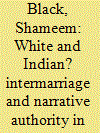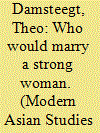| Srl | Item |
| 1 |
ID:
175487


|
|
|
|
|
| Summary/Abstract |
The influential Tamil writer Pudumaippittan turned to the short story to theorise the relationship between literature and society in the late colonial era. He used the genre’s brevity to compress his portrayals of well-known female types—such as widows, prostitutes and goodwives—into singular emotional events. This enabled Pudumaippittan to evoke the wider debates about tradition and modernity that these female types commonly represented without affirming the social reformist positions to which they were linked. Through the short story, Pudumaippittan dislodged his portrayals of the Indian woman from existing gender norms, prompting a shift from social realism to modernist realism within the Tamil literary sphere.
|
|
|
|
|
|
|
|
|
|
|
|
|
|
|
|
| 2 |
ID:
120710


|
|
|
|
|
| Publication |
2013.
|
| Summary/Abstract |
How does intermarriage affect a storyteller? In this essay, I seek to examine literary narratives of South Asian family formation that take late twentieth-century intermarriages-particularly between Indian men and white American women-as their central governing trope. This phenomenon raises two linked questions: first, how do South Asian families recruit or reject individuals within constructs of South Asian identity; and second, to what extent do individuals not of South Asian descent gain the authority to imagine and re-imagine the contours of their multiracial family? I here examine the work of the white American writer Robbie Clipper Sethi, whose novel-in-stories, The Bride Wore Red (1996), tells the unfolding saga of a multiracial South Asian family in the United States and India. These narratives of white women socialised into ambivalent places within larger South Asian families, I argue, figure larger anxieties about imaginative representation across the mobile borders of what is considered one's culture. The family structure emerges as a contradictory space that empowers this border-crossing representational authority by simultaneously calling this authority into question.
|
|
|
|
|
|
|
|
|
|
|
|
|
|
|
|
| 3 |
ID:
087780


|
|
|
|
|
| Publication |
2008.
|
| Summary/Abstract |
In Varma's story 'Pata-banethi', a robust young man refuses to marry a female student when he finds out that she is trained in defensive violence, as a virangana. At first sight, the story appears to draw attention to the difficulties women trained like men in fighting will have in getting married and finding a place in society. An analysis of characterisation, however, suggests that Varma's story goes against such a stereotypic male evaluation of strong women, and actually underlines the social and political value of violence controlled by mental strength, a value that can be recognised by both men and women.
|
|
|
|
|
|
|
|
|
|
|
|
|
|
|
|